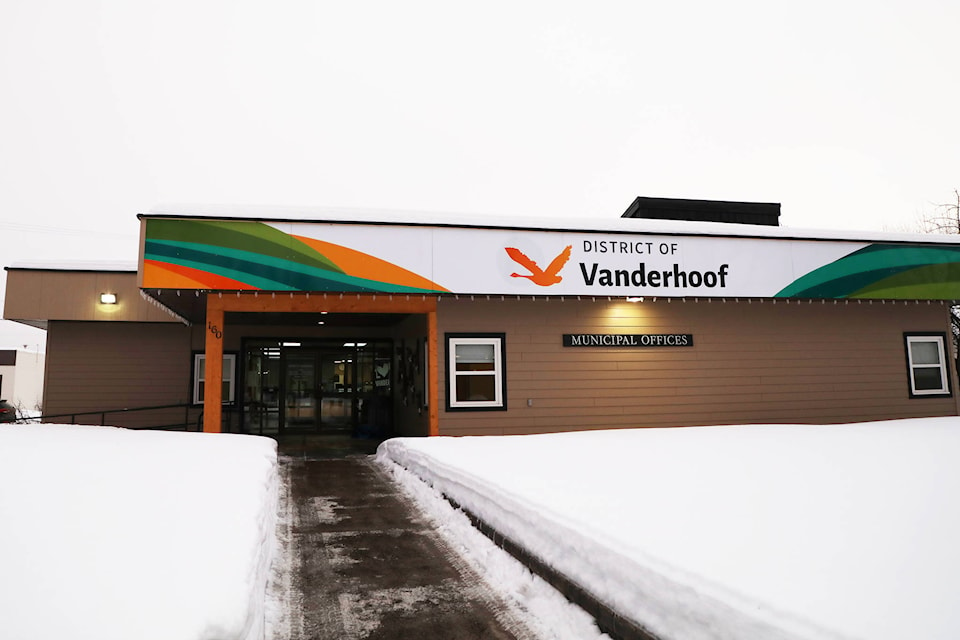The district will be giving Vanderhoof’s financial plan, first and second reading Monday, March 23.
In 2020, grants and other government funds form the greatest proportion of revenue, as per municipal documents.
Property and parcel taxes form the second greatest proportion of revenue this year.
As a revenue source, property taxation,”offers a stable and reliable source of revenue for services that are difficult or undesirable to fund on a user-pay basis. These include services such as general administration, fire protection, snow removal, bylaw enforcement and street lighting,” states the 2020-2024 Financial Plan, statement of objectives for Vanderhoof.
Reserves and surplus rank third in revenue.
Meanwhile, user fees and charges form a minor portion of planned revenue, the document states. And the district plans to change that.
“Fees are charged for services that can be measured on a user-pay basis. Services where fees and charges can be easily administered include water and sewer usage, building permits, business licenses, garbage collection and sale of services.”
“User fees attempt to apportion the value of a service to those who use the service.”
The objective of the financial plan is that over the next five years, the district will increase the proportion of revenue that is received from user fees and charges, by the annual CPI rate over the current levels, and consider new fees.
So policy wise, wherever possible, the district is going to work towards supplementing revenues from user fees and charges, rather than taxation, “to lessen the burden on its limited property tax base.”
Tax increase this year to residents is at two percent, which is consistent with the increasing cost of living, stated officials at a March 16 Committee of the Whole Meeting.
In terms of the General Operating Fund in the 2020 Annual Budget, revenue and expenditure is distributed as follows:
Total Revenue:
$14,778,916
1. Property Taxation: $5,404,037
2. Grants in Lieu of Taxes: $305,985
3. Unconditional Transfers from Province: $550,000
4. Conditional Transfers from Province: $642,275
5. Conditional Grants from Other Governments: $2,874,545
6. Sale of Services: $339,471
7. Community Forest Revenue: $1,937,409
8. Other Revenue from Own Sources: $435,557
9. Appropriations from Own Reserves/Surplus: $2,289,637
Total Expenses: $14,778,916
1. General Government: $1,494,297
2. Public Works: $1,561,900
3. Air Services: $81,800
4. Environmental Health Services: $167,050
5. Recreation and Cultural: $2,321,307
6. Protective Services: $625,570
7. Fiscal Services: $216,947
8. Community Forest: $56,500
9. Appropriation to General Capital: $5,107,909
10. Appropriation to Own Reserves: $3,145,636
Capital Expenditure Program for 2020
General Government:
1. Equipment: $15,000
2. Buildings: $85,000
Protective Services:
1. Equipment: $50,000
Transportation Services:
1. Airport: $677,724
2. Roads & Sidewalks: $1,263,653
3. Equipment: $762,047
Environmental Health:
1. Sewer: $627,690
2. Water: $692,251
3. Storm Sewer: $50,000
Recreational & Cultural:
1. Buildings: $1,448,000
2. Equipment: $47,023
3. Parks: $709,462
Total expenditure is $6,427,850.
And funding for this expense is coming from:
1. Sewer Utility Fund: $91,306
2. Water Utility Fund: $146,701
3. Reserves: $1,777,152
4. Grants: $3,289,967
5. General Revenue: 445,724
6. Borrowing: $677,000
The Omineca Express will be publishing the Water and Sewer Operating Fund, Equipment Reserve Fund, General Capital Fund, Water Capital Fund, Sewer Capital Fund and the financial plan in upcoming stories. Stay tuned.
Aman Parhar
Editor, Vanderhoof Omineca Express
aman.parhar@ominecaexpress.com
Like us on Facebook and follow us on Twitter
